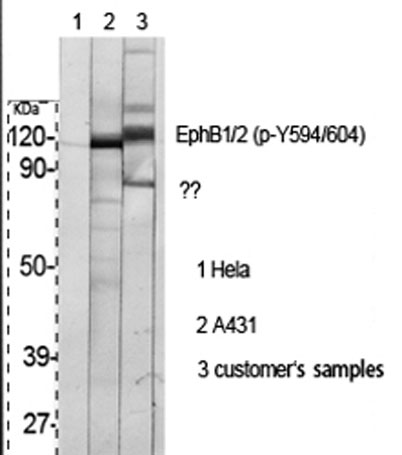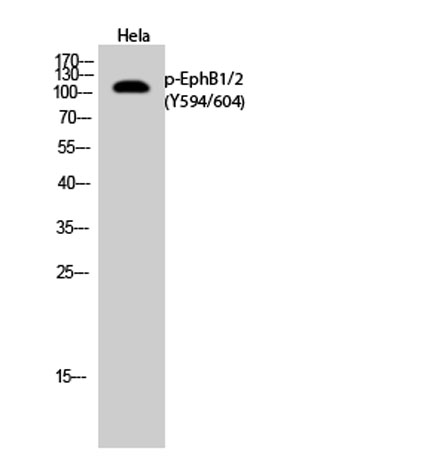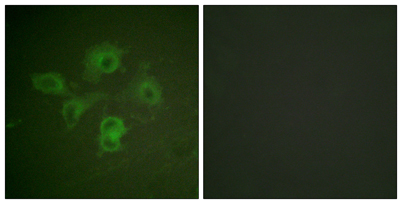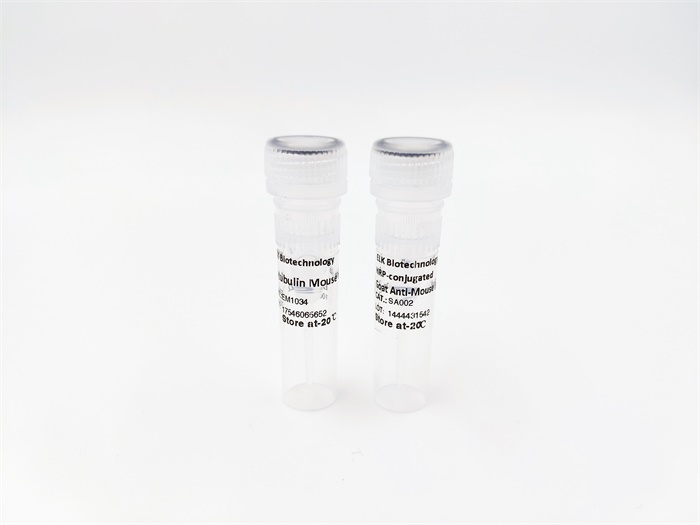









EphB1/2 (phospho Tyr594/604) rabbit pAb
 One-click to copy product information
One-click to copy product information$148.00/50µL $248.00/100µL
| 50 µL | $148.00 |
| 100 µL | $248.00 |
Overview
| Product name: | EphB1/2 (phospho Tyr594/604) rabbit pAb |
| Reactivity: | Human;Mouse;Rat |
| Alternative Names: | EPHB1; ELK; EPHT2; HEK6; NET; Ephrin type-B receptor 1; ELK; EPH tyrosine kinase 2; EPH-like kinase 6; EK6; hEK6; Neuronally-expressed EPH-related tyrosine kinase; NET; Tyrosine-protein kinase receptor EPH-2; EPHB2; DRT; EPHT3; EPTH3; ERK; |
| Source: | Rabbit |
| Dilutions: | Western Blot: 1/500 - 1/2000. Immunofluorescence: 1/200 - 1/1000. ELISA: 1/5000. Not yet tested in other applications. |
| Immunogen: | The antiserum was produced against synthesized peptide derived from human EPHB1/2 around the phosphorylation site of Tyr594/604. AA range:561-610 |
| Storage: | -20°C/1 year |
| Clonality: | Polyclonal |
| Isotype: | IgG |
| Concentration: | 1 mg/ml |
| Observed Band: | 110kD |
| GeneID: | 2047/1969 |
| Human Swiss-Prot No: | P54762/P29323 |
| Cellular localization: | Cell membrane ; Single-pass type I membrane protein . Early endosome membrane . Cell projection, dendrite . |
| Background: | Ephrin receptors and their ligands, the ephrins, mediate numerous developmental processes, particularly in the nervous system. Based on their structures and sequence relationships, ephrins are divided into the ephrin-A (EFNA) class, which are anchored to the membrane by a glycosylphosphatidylinositol linkage, and the ephrin-B (EFNB) class, which are transmembrane proteins. The Eph family of receptors are divided into 2 groups based on the similarity of their extracellular domain sequences and their affinities for binding ephrin-A and ephrin-B ligands. Ephrin receptors make up the largest subgroup of the receptor tyrosine kinase (RTK) family. The protein encoded by this gene is a receptor for ephrin-B family members. [provided by RefSeq, Jul 2008], |
-
 Western Blot analysis of various cells using Phospho-EphB1/2 (Y594/604) Polyclonal Antibody
Western Blot analysis of various cells using Phospho-EphB1/2 (Y594/604) Polyclonal Antibody -
 Western Blot analysis of Hela cells using Phospho-EphB1/2 (Y594/604) Polyclonal Antibody
Western Blot analysis of Hela cells using Phospho-EphB1/2 (Y594/604) Polyclonal Antibody -
 Immunofluorescence analysis of HUVEC cells, using EPHB1/2 (Phospho-Tyr594/604) Antibody. The picture on the right is blocked with the phospho peptide.
Immunofluorescence analysis of HUVEC cells, using EPHB1/2 (Phospho-Tyr594/604) Antibody. The picture on the right is blocked with the phospho peptide. -
 Western blot analysis of lysates from HepG2 cells, using EPHB1/2 (Phospho-Tyr594/604) Antibody. The lane on the right is blocked with the phospho peptide.
Western blot analysis of lysates from HepG2 cells, using EPHB1/2 (Phospho-Tyr594/604) Antibody. The lane on the right is blocked with the phospho peptide.

 Manual
Manual